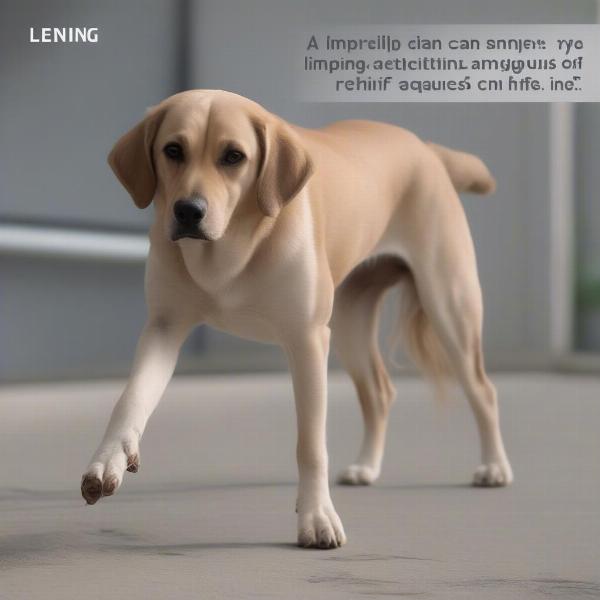The stifle joint in dogs, often compared to the human knee, is a complex and crucial part of their anatomy, enabling them to run, jump, and play. Understanding its structure and function is essential for any dog owner, especially when it comes to recognizing potential issues and ensuring proper care. This article will delve into the details of the stifle dog, covering everything from its anatomy and common problems to diagnosis, treatment, and preventative measures.
Anatomy of the Canine Stifle
The stifle joint is formed where the femur (thigh bone), tibia (shin bone), and patella (kneecap) meet. It’s a complex structure composed of ligaments, tendons, cartilage, and joint fluid, all working together to provide stability and facilitate movement. The cranial cruciate ligament (CCL), similar to the ACL in humans, is a key stabilizer within the stifle.
Common Stifle Problems in Dogs
A variety of issues can affect the canine stifle, ranging from developmental problems to traumatic injuries. Cranial cruciate ligament (CCL) rupture is perhaps the most frequently encountered problem, often resulting from sudden twisting motions or repetitive stress. Other common stifle conditions include patellar luxation, where the kneecap dislocates from its normal position, and meniscal tears, which can occur in conjunction with CCL injuries. Arthritis, a degenerative joint disease, can also affect the stifle, particularly in older dogs.
Diagnosing Stifle Issues
Diagnosing stifle problems requires a thorough veterinary examination, including physical manipulation of the joint and often imaging techniques such as X-rays or MRI. Observing your dog’s gait, noting any limping, stiffness, or difficulty rising, can also provide valuable clues.  Dog Limping Due to Stifle Problem
Dog Limping Due to Stifle Problem
Treatment Options for Stifle Conditions
Treatment for stifle problems varies depending on the specific condition and its severity. Conservative management, such as rest, pain medication, and physical therapy, may be sufficient for mild cases. However, surgical intervention is often necessary for more severe injuries, such as CCL ruptures. Several surgical techniques are available, each with its own benefits and drawbacks. dog brace for back legs
Preventing Stifle Injuries
While not all stifle problems are preventable, certain measures can help reduce the risk. Maintaining a healthy weight for your dog is crucial, as excess weight puts added stress on the joints. Regular, moderate exercise helps strengthen the muscles surrounding the stifle and promotes joint health. Avoiding sudden, forceful movements, especially during play, can also help protect the ligaments. dog cool coats
Caring for a Dog After Stifle Surgery
Post-operative care is essential for a successful recovery after stifle surgery. This typically involves strict rest, pain management, and a gradual return to activity under the guidance of your veterinarian. Physical therapy plays a vital role in regaining strength and mobility. stifle of a dog
Conclusion
The stifle joint is a vital component of a dog’s mobility. Understanding its structure and common problems, as well as implementing preventative measures, is crucial for responsible dog ownership. By being attentive to your dog’s gait and seeking veterinary attention promptly for any signs of lameness, you can help ensure your canine companion enjoys a long and active life. dog back leg brace
FAQ
-
What are the signs of a stifle problem in a dog? Limping, stiffness, difficulty rising, swelling, and pain are common signs.
-
How is a stifle injury diagnosed? Through a physical exam, often supplemented by X-rays or MRI.
-
What is the most common stifle injury in dogs? Cranial cruciate ligament (CCL) rupture.
-
Is surgery always necessary for stifle problems? No, conservative treatment may suffice for mild cases.
-
How can I prevent stifle injuries in my dog? Maintaining a healthy weight, regular exercise, and avoiding forceful movements can help.
-
What is involved in post-operative care for stifle surgery? Rest, pain management, and a gradual return to activity with physical therapy.
-
How long does it take for a dog to recover from stifle surgery? Recovery time varies but generally takes several weeks to months.
About ILM Dog
ILM Dog is your trusted global resource for all things dog-related. We offer expert advice on breeds, health, training, nutrition, grooming, and much more. From puppy care to senior dog support, we are dedicated to helping you provide the best possible care for your canine companion. For personalized guidance on products, training, or any other aspect of dog care, contact our expert team at [email protected] or call us at +44 20-3965-8624. ILM Dog – Your partner in responsible dog ownership.